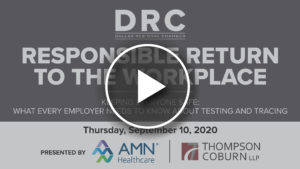Michael Wood, Manager, Education & Workforce
Establishing COVID-19 testing and contact tracing processes is key to facilitating a safe return to the workplace. For the majority of employers, however, developing such protocols is uncharted territory, leaving many unsure of where or how to begin.
During the Dallas Regional Chamber’s “Responsible Return to the Workplace” event presented by AMN Healthcare and Thompson Coburn, LLP, health, legal, and technology experts convened to help business leaders navigate this complex issue.
Testing and Tracing
The first step for any employer is to differentiate between ‘testing’ and ‘screening,’ and assess the individual organization’s unique need for both. Screening involves surveying employees about relevant symptoms, potential contact with individuals who have contracted COVID-19, and travel history, whereas testing involves the actual administration of or requirement that employees receive a viral test to determine if a COVID-19 infection is present.
Screening, then, is something all employers can – and likely should – do. As for testing, employers need to decide whether they want to pursue on-site testing or rely on publicly available avenues should an employee exhibit symptoms or come into contact with someone with the virus.
As employers contemplate this decision, Clint Clevenger, Portfolio Manager of Strategic Talent Solutions for AMN Healthcare, encouraged leaders to plan for and answer four key questions related to testing in the workplace.
One, what are the goals an employer is hoping to accomplish through testing? Two, what is the proposed cadence of testing, or what indicators lead to testing? Three, how will testing be administered? And four, what happens after the test, particularly if it comes back positive?
Regardless of an employer’s testing strategy, contact tracing is what follows a suspected or confirmed case of COVID-19.
“Tracing comes down to, once you have identified an employee that [potentially] had COVID on-site within the facility, determining how many other people they came in contact with,” said Clevenger.
This is an arduous process, particularly if done manually. Noel Hara, Senior Director of Public Sector Capture & Strategy for NTT Data, remarked that most companies have neither the staff bandwidth nor organizational capacity to undertake a fully manual contact tracing program.
“Some very large employers are running this process on Excel,” said Hara. “I met with one company that had 75 full-time employees dedicated to contact tracing right now. [That is] not sustainable.”
Fortunately, technology can enhance contact tracing efforts and reduce some of the burden on employers. Those in an office setting, for example, may take advantage of a tool that combs through Outlook calendars to assess which employees were scheduled to be in meetings together. Employers may also consider tracking-enabled badges or wristbands that employees keep on their person in the workplace, allowing employers to determine which employees came into close proximity with one another, at what times, and for how long.
Legal Liabilities
Complicating matters further for employers, however, are the legal implications that accompany testing and contact tracing. Since the pandemic began, more than 600 lawsuits have been filed nationally against employers, primarily related to issues of privacy and liability.
First and foremost, employers should ensure they keep any information collected about employee health – whether through screenings or actual viral testing – confidential and secure in compliance with relevant state laws and HIPAA guidelines, stressed John Viola, Partner at Thompson Coburn. To this end, Viola suggests that employers conduct on-site screenings in private and avoid disclosing the identities any employees that test positive for COVID-19 while still taking proper precautions to inform staff of confirmed cases.
Contact tracing programs have also prompted privacy concerns. Viola recommends that employers clearly communicate to employees what information is being collected and how it will be used. Data should also only be collected while employees are in the workplace. To further assuage concerns, employers should minimize the information they collect and reduce the amount of time it is stored.
Other suits against employers charge that not enough was done to protect employees from contracting COVID-19 in the workplace, such as failure to provide PPE, or establish testing and tracing protocols. To prevent such charges, employers should establish comprehensive policies in accordance with local, state, and federal guidance. These policies should be well documented and communicated clearly and frequently to employees.
Operational Impacts
Another concern for employers is the impact positive COVID-19 cases may have on their day-to-day operations. Individuals with similar job functions tend to sit near one another in the office, noted Clevenger. As a result, a single COVID-19 case could sideline an essential department. In addition to implementing testing and tracing protocols, employers should consider reorganizing the workspace layout to soften the adverse impacts of a potential COVID-19 outbreak.
Employers can also play a crucial role in preventing the spread of COVID-19 outside of the workplace. Dr. Kelvin Baggett, Senior Advisor at Pharos Capital Group and the City of Dallas’ “COVID-19 Czar,” noted that consumption of available testing in the city and county has plummeted. Businesses should remain persistent in promoting awareness and best practices among their employees and the communities they serve.
“Stay on guard, stay vigilant, in any circles that you can encourage that, be they in the workplace or be they in your social settings or community settings,” said Dr. Baggett. “Quite frankly… If other places can [contain this virus], Dallas certainly can.”
